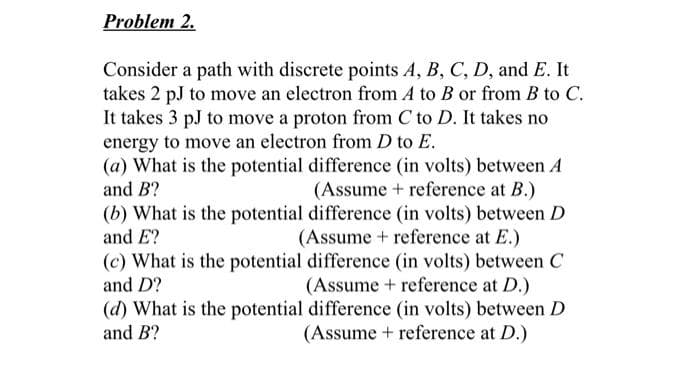Consider a path with discrete points A, B, C, D, and E. It takes 2 pJ to move an electron from A to B or from B to C. It takes 3 pJ to move a proton from C to D. It takes no energy to move an electron from D to E. (a) What is the potential difference (in volts) between A (Assume + reference at B.) (b) What is the potential difference (in volts) between D (Assume + reference at E.) (c) What is the potential difference (in volts) between C (Assume + reference at D.) (d) What is the potential difference (in volts) between D (Assume + reference at D.) and B? and E? and D? and B?
Consider a path with discrete points A, B, C, D, and E. It takes 2 pJ to move an electron from A to B or from B to C. It takes 3 pJ to move a proton from C to D. It takes no energy to move an electron from D to E. (a) What is the potential difference (in volts) between A (Assume + reference at B.) (b) What is the potential difference (in volts) between D (Assume + reference at E.) (c) What is the potential difference (in volts) between C (Assume + reference at D.) (d) What is the potential difference (in volts) between D (Assume + reference at D.) and B? and E? and D? and B?
Principles of Physics: A Calculus-Based Text
5th Edition
ISBN:9781133104261
Author:Raymond A. Serway, John W. Jewett
Publisher:Raymond A. Serway, John W. Jewett
Chapter20: Electric Potential And Capacitance
Section: Chapter Questions
Problem 14OQ: Four particles are positioned on the rim of a circle. The charges on the particles are +0.500 C,...
Related questions
Question
100%

Transcribed Image Text:Problem 2.
Consider a path with discrete points A, B, C, D, and E. It
takes 2 pJ to move an electron from A to B or from B to C.
It takes 3 pJ to move a proton from C to D. It takes no
energy to move an electron from D to E.
(a) What is the potential difference (in volts) between A
(Assume + reference at B.)
(b) What is the potential difference (in volts) between D
(Assume + reference at E.)
(c) What is the potential difference (in volts) between C
(Assume + reference at D.)
(d) What is the potential difference (in volts) between D
(Assume + reference at D.)
and B?
and E?
and D?
and B?
Expert Solution
This question has been solved!
Explore an expertly crafted, step-by-step solution for a thorough understanding of key concepts.
Step by step
Solved in 2 steps with 1 images

Knowledge Booster
Learn more about
Need a deep-dive on the concept behind this application? Look no further. Learn more about this topic, physics and related others by exploring similar questions and additional content below.Recommended textbooks for you

Principles of Physics: A Calculus-Based Text
Physics
ISBN:
9781133104261
Author:
Raymond A. Serway, John W. Jewett
Publisher:
Cengage Learning


Physics for Scientists and Engineers, Technology …
Physics
ISBN:
9781305116399
Author:
Raymond A. Serway, John W. Jewett
Publisher:
Cengage Learning

Principles of Physics: A Calculus-Based Text
Physics
ISBN:
9781133104261
Author:
Raymond A. Serway, John W. Jewett
Publisher:
Cengage Learning


Physics for Scientists and Engineers, Technology …
Physics
ISBN:
9781305116399
Author:
Raymond A. Serway, John W. Jewett
Publisher:
Cengage Learning

Physics for Scientists and Engineers: Foundations…
Physics
ISBN:
9781133939146
Author:
Katz, Debora M.
Publisher:
Cengage Learning

Physics for Scientists and Engineers
Physics
ISBN:
9781337553278
Author:
Raymond A. Serway, John W. Jewett
Publisher:
Cengage Learning

Physics for Scientists and Engineers with Modern …
Physics
ISBN:
9781337553292
Author:
Raymond A. Serway, John W. Jewett
Publisher:
Cengage Learning